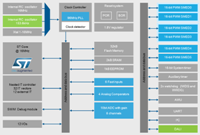A programmable controller for LED lighting combines state machines for autonomous current control with the capability of DALI network support and flexibility in topology.
The new STLUX385 digital lighting controller IC from STMicroelectronics combines the capability of implementing LED-driver functionality with the ability to implement smart solid-state lighting (SSL) products including network support. The IC combines a programmable microcontroller (MCU), state-machine-driven pulse-width modulation (PWM) peripherals, and hardware support for the Digital Addressable Lighting Interface (DALI) network.

Most LED driver ICs have a relatively fixed topology. And in cases where luminaire designers want to add intelligence to a product, the typical path is via a secondary MCU IC. The STLUX385 is an MCU that also has the ability to implement driver functionality with the flexibility of supporting different topologies.
Generally, MCUs integrate a microprocessor core, memory, and a mix of peripheral functionality that might include connectivity support and data converters. The STLUX385 fits that description and includes what STMicroelectronics calls SMED (State Machine, Event Driven) peripherals that are specifically designed for lighting applications.
The six integrated SMED peripherals can be set by the MCU, and can then autonomously drive LED strings using PWM control. The SMED peripherals can control the on/off state of LEDs, set dimming levels, detect failures, and accept input from sensors. For example, the SMED peripherals can adjust light levels based on input from occupancy or ambient light sensors without assistance from the processor.
STMicroelectronics said that the IC targets a broad variety of applications but specifically mentioned street-light applications. The IC could deliver more granular control of light level – for example gradually increasing light level at dusk.
The new IC is designed for SSL applications but can also be utilized with HID sources. For example, the DALI interface is an advantage for control applications regardless of light-source type.
STMicroelectronics has presented a number of use cases for the IC in different power-supply topologies. For example, the company presented a typical street-light design that includes a power factor conversion stage and a half-bridge power converter. The company also presented a buck converter example.
In the case of SSL applications, the IC can implement a multi-channel driver. STMicroelectronics has an evaluation board that includes a single STLUX385 IC and hour LED driver channels using individual buck converters with support for 8-bit dimming granularity.





